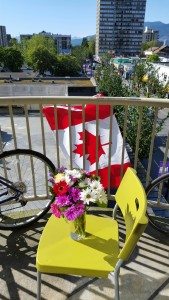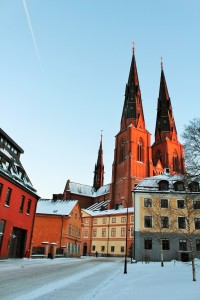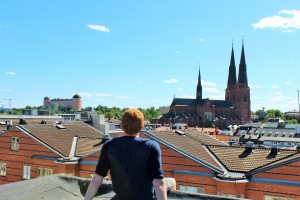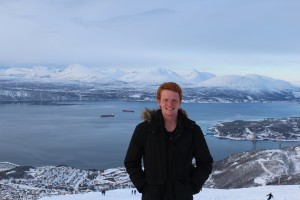Our adventures began before the trip did! Those of us who arrived in Chiang Mai, Thailand a bit early didn’t waste time in exploring the city. Hopping in an infamous tuk tuk we headed up the windy road to visit Wat Palad, Wat Phra That Doi Suthep Ratchwarawihan, and the Hmong village of Doi Pui. This day provided my first impression of Chiang Mai and set the tone for the remainder of the trip. Our first destination was Wat Palad. This temple was one of my favorites of those we saw throughout the trip, (and we saw a lot)! This temple was tucked away into the jungle and completely surrounded by nature. It was very peaceful to explore the area following footpaths and stopping to look at Buddha statues or the incredible view of the city. 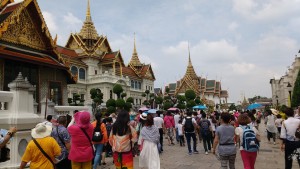
Day 3 commenced with our first of the NGO site visits, Art Relief International (ARI) and Child’s Dream. These two organizations could not have been in starker contrast to one another. While ARI is Western run and staffed, Child’s Dream recognized the importance of having local staff members for their organization. The age and stability of the organizations were also very different, as Child’s Dream has formed a long duration of stability, financially and otherwise. It will be interesting to see how these two organizations transform in the future.
 Our last full day in Chiang Mai was spent at the Save Elephant Foundation’s Elephant Nature Park. While during our visit to the Elephant Nature Park we learned an extensive amount about SEF from our tour guide Ten, we did not have a formal meeting with a staff member as with the previous two organizations, but rather took on the role of the tourist and visited the park for a tour.
Our last full day in Chiang Mai was spent at the Save Elephant Foundation’s Elephant Nature Park. While during our visit to the Elephant Nature Park we learned an extensive amount about SEF from our tour guide Ten, we did not have a formal meeting with a staff member as with the previous two organizations, but rather took on the role of the tourist and visited the park for a tour.
We then traveled as a group by plane from Chiang Mai to Bangkok, Thailand. While I knew how large of a city Bangkok was, it blew away my expectations. Bangkok is huge. Surrounded by skyscrapers and traffic that would put New York City to shame, I realized just how much I had underestimated the city of Bangkok. However, what really shocked me about Bangkok was the stark contrast between the wealthy and the poor. Even in such a large city with an amazing sky train system and designer fashion in malls as massive as MBK Center (which we visited), there was still an extensive visual representation of poverty along the streets. While this can be said of large cities in the United States as well, the contrast was more defined in Bangkok. My expectations had been that of the exact opposite.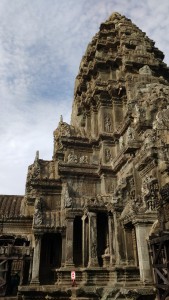
The tour of Angkor Village was equally as breathtaking. The history could be seen throughout the area and was very powerful. We learned that during the Khmer Rouge, Angkor village became a battlefield between the Khmer Rouge and Vietnamese army as the Vietnamese tried to push the Khmer out. As a result, some statues are missing and many have been beheaded as was seen on our tour. It’s a powerful feeling to know you’re standing on a place of such strong history. During our tour we visited Angkor Wat, Angkor Ta Prohm, and Angkor Bayon.
We later visited schools run by the Ponheary Ly Foundation, the Kor Ker school in a rural area outside of the city of Siem Reap and the Knar school closer to town. It was so much fun working with the kids to make their lunch, getting to watch some lessons take place, serving the kiddos as much ramen as they could possibly eat, and then playing with them afterwards.
We also stopped at the Cambodian Landmine Museum. This Museum was very powerful. Aki Ra, founder of the Museum and attached Relief Facility, laid thousands of landmines as a child soldier with the Khmer Rouge. Today, it is estimated that he has cleared over 50,000. I spent most of my time at the museum at one exhibit in particular. A wall displayed the photographs and stories of children who were affected by land mines. Each of the stories was incredible. One boy wrote that at 8 years old while feeding the cows with several other children, he watched a friend pick up an unknown object. The object exploded, killing three boys, taking off one girl’s arm, and his leg from the middle of the thigh down. It’s impossible to fully comprehend what it might be like to live in constant fear of a tragedy like this. There are still estimated to be thousands of landmines that haven’t yet been cleared. While living their daily lives, such as feeing the cows, there is the constant threat of an explosion. I can’t imagine the feeling of insecurity that this must have on people.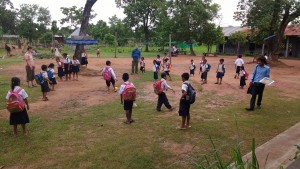
We then visited our last three organizations, Groupe Energies Renouvelables, Environnement et Solidarites (GERES), Better Factories Cambodia, Daughters of Cambodia, and Equitable Cambodia.
On our last day our group said our farewells and departed on our next adventures. While some students were headed home, others had further travel ahead of them, including three month internships with NGOs, a study abroad opportunity in London, personal travel, or like myself and a fellow graduate student, continuing travel with our Professor to assist with research in Laos! While we left exhausted from our busy time together, the lessons we learned from the NGOs we met with were irreplaceable. This experience shaped me as a traveler as well as my knowledge of NGOs around the world. Time will tell just how very valuable this experience has been.
-Emily Edwards, Summer 2016

